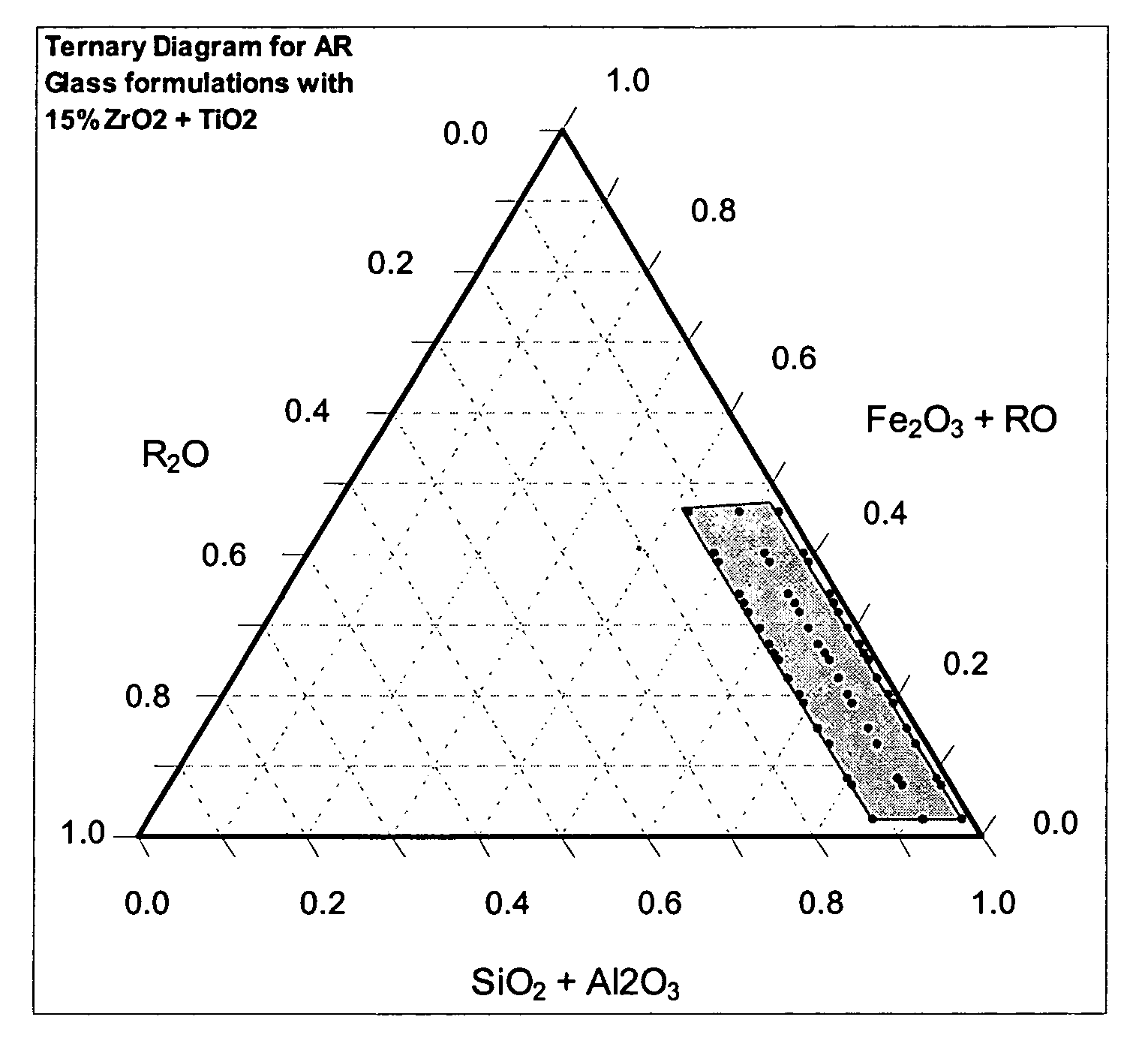Alkali resistant glass compositions
a technology of alkali resistance and glass, applied in the field of glass compositions, can solve the problems of weak mechanical bonding to the surrounding cement matrix, severely limited use of glass in reinforcing concrete, and rapid corrosion of silicate glasses, etc., to achieve the effect of improving the alkali resistance of glass articles, increasing the durability of spherical walls, and high ph environmen
- Summary
- Abstract
- Description
- Claims
- Application Information
AI Technical Summary
Benefits of technology
Problems solved by technology
Method used
Image
Examples
example a
[0072]An aqueous alkaline solution as was prepared with 2.343 g / L of LiOH, and 0.080 g / L of Ca (OH)2 at a pH of about 13.0. The test materials included a commercially available coal ash cenosphere (produced at 4 Corners power plant, and sold by Phoenix Cement), commercial soda lime microspheres (sold under trade name of SISCOR by Spherical Industrial Solutions, Toronto-Canada), and synthetically produced spherical microparticles according to one embodiment of the present invention, identified as sample X. The alkaline solution was heated to 180° C. and the test materials were left to soak for 5 hours. The solid charge was 0.25 g in 15 ml of solution for all the three materials. The leach tests were performed at 180° C. after a duration of 5 hours. Table 2 summarizes the major oxide constituents of the three test specimens.
[0073]
TABLE 2Phoenix Cement cenosphereSISCORXSiO264.671.247.9Al2O325.83.920.6CaO0.99.613K2O1.60.71.2Fe2O34.10.37.7TiO20.50.11.2MgO1.31.93.3Na2O1.112.15BET surface ...
example b
[0078]In the following example, additional commercial products were tested, including 3M-S32: SCOTCHLITE®, manufactured by 3M Corp., of Minnesota; PORAVER®, manufactured by Spherical Industrial Solution of Toronto, Canada; SPHERIGLASS®, made by PQ Corp, USA; and SIL-CELL®, made by Silbrico Corp., USA. Table 4 lists the major oxides contained in the Example B products.
[0079]
TABLE 4MATERIALS3M-S32PORAVERSPHERIGLASSSIL-CELLSiO278.673.174.981.1Al2O30.53.70.711.0CaO13.19.49.40.6K2O0.10.80.15.2Fe2O30.10.40.61.6TiO20.00.10.10.1MgO0.22.140.1Na2O7.314.814.52.9
[0080]The leach data for 5 h leach at conditions described previously of the samples listed in Table 4 are presented in the following Table 5:
[0081]
TABLE 5MATERIALSPercent of oxidesleached out wt. %3M-S32PORAVERSPHERIGLASSSIL-CELLSiO227.236.320.527.7Al2O34.72.313.11.1CaO4.80.90.010.9K2O10060.210012.1Fe2O35.90.60.30.8TiO27.72.02.42.6MgO2.20.10.022.8Na2O51.973.642.450.4Total Percentage25.938.121.825.4leached at 5 hTotal percentage leached...
example c
[0083]Example C testing was carried out to quantify the effects of adding small amounts of zirconia to embodiments of the present invention to determine the improved alkali resistance. In the following examples, samples 1A, 1B, 1C, and 1D were prepared according to embodiments of the present invention. These samples of alkali resistant glass were made from formulations consisting of fly ash, sodium hydroxide, zirconium silicate and sugar. The samples were prepared by mixing the ingredients according to the formulations as shown in Table 6.
[0084]
TABLE 6Formulations for the samplesNaOHZirconiumFly ash(flakes)SugarsilicateWater(g)(g)(g)(g)(g)1A92530251B90.5531.5281C89533281D8653627
[0085]Sample 2A is a sample of commercially available alkali resistant glass having a nominal 0% zirconium oxide content. Sample 2B is a sample of commercially available alkali resistant glass having a nominal 15% zirconium oxide content. Sample 2C is a sample of commercially available alkali resistant glass ...
PUM
| Property | Measurement | Unit |
|---|---|---|
| temperatures | aaaaa | aaaaa |
| temperatures | aaaaa | aaaaa |
| temperature | aaaaa | aaaaa |
Abstract
Description
Claims
Application Information
 Login to View More
Login to View More - R&D
- Intellectual Property
- Life Sciences
- Materials
- Tech Scout
- Unparalleled Data Quality
- Higher Quality Content
- 60% Fewer Hallucinations
Browse by: Latest US Patents, China's latest patents, Technical Efficacy Thesaurus, Application Domain, Technology Topic, Popular Technical Reports.
© 2025 PatSnap. All rights reserved.Legal|Privacy policy|Modern Slavery Act Transparency Statement|Sitemap|About US| Contact US: help@patsnap.com



